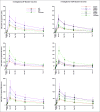A phase I, randomized, controlled, dose-ranging study of investigational acellular pertussis (aP) and reduced tetanus-diphtheria-acellular pertussis (TdaP) booster vaccines in adults
- PMID: 29172945
- PMCID: PMC5791588
- DOI: 10.1080/21645515.2017.1385686
A phase I, randomized, controlled, dose-ranging study of investigational acellular pertussis (aP) and reduced tetanus-diphtheria-acellular pertussis (TdaP) booster vaccines in adults
Abstract
Despite high vaccination coverage worldwide, pertussis has re-emerged in many countries. This randomized, controlled, observer-blind phase I study and extension study in Belgium (March 2012-June 2015) assessed safety and immunogenicity of investigational acellular pertussis vaccines containing genetically detoxified pertussis toxin (PT) (NCT01529645; NCT02382913). 420 healthy adults (average age: 26.8 ± 5.5 years, 60% female) were randomized to 1 of 10 vaccine groups: 3 investigational aP vaccines (containing pertussis antigens PT, filamentous hemagglutinin [FHA] and pertactin [PRN] at different dosages), 6 investigational TdaP (additionally containing tetanus toxoid [TT] and diphtheria toxoid [DT]), and 1 TdaP comparator containing chemically inactivated PT. Antibody responses were evaluated on days 1, 8, 30, 180, 365, and approximately 3 years post-booster vaccination. Cell-mediated immune responses and PT neutralization were evaluated in a subset of participants in pre-selected groups. Local and systemic adverse events (AEs), and unsolicited AEs were collected through day 7 and 30, respectively; serious AEs and AEs leading to study withdrawal were collected through day 365 post-vaccination. Antibody responses against pertussis antigens peaked at day 30 post-vaccination and then declined but remained above baseline level at approximately 3 years post-vaccination. Responses to FHA and PRN were correlated to antigen dose. Antibody responses specific to PT, toxin neutralization activity and persistence induced by investigational formulations were similar or significantly higher than the licensed vaccine, despite lower PT doses. Of 15 serious AEs, none were considered vaccination-related; 1 led to study withdrawal (premature labor, day 364; aP4 group). This study confirmed the potential benefits of genetically detoxified PT antigen. All investigational study formulations were well tolerated.
Keywords: adults; genetically detoxified PT; immunogenicity; persistence; pertussis; safety.
Figures







Similar articles
-
Safety and immunogenicity of SIIPL Tdap, a new tetanus toxoid, reduced diphtheria toxoid and acellular pertussis vaccine, in healthy subjects 4-65 years of age: A Phase II/III randomized, observer-blinded, active controlled, multicenter clinical study in Germany.Vaccine. 2023 Nov 2;41(46):6810-6819. doi: 10.1016/j.vaccine.2023.09.060. Epub 2023 Oct 10. Vaccine. 2023. PMID: 37827966 Clinical Trial.
-
Safety and immunogenicity of a combined Tetanus, Diphtheria, recombinant acellular Pertussis vaccine (TdaP) in healthy Thai adults.Hum Vaccin Immunother. 2017 Jan 2;13(1):136-143. doi: 10.1080/21645515.2016.1234555. Epub 2016 Sep 29. Hum Vaccin Immunother. 2017. PMID: 27686283 Free PMC article. Clinical Trial.
-
A genetically inactivated two-component acellular pertussis vaccine, alone or combined with tetanus and reduced-dose diphtheria vaccines, in adolescents: a phase 2/3, randomised controlled non-inferiority trial.Lancet Infect Dis. 2018 Jan;18(1):58-67. doi: 10.1016/S1473-3099(17)30612-6. Epub 2017 Oct 20. Lancet Infect Dis. 2018. PMID: 29066131 Clinical Trial.
-
Reduced-antigen, combined diphtheria, tetanus and acellular pertussis vaccine, adsorbed (Boostrix®): a review of its properties and use as a single-dose booster immunization.Drugs. 2012 Sep 10;72(13):1765-91. doi: 10.2165/11209630-000000000-00000. Drugs. 2012. PMID: 22931522 Review.
-
Reduced-antigen, combined diphtheria-tetanus-acellular pertussis vaccine, adsorbed (Boostrix) US formulation): use as a single-dose booster immunization in adolescents aged 10-18 years.Paediatr Drugs. 2006;8(3):189-95; discussion 196. doi: 10.2165/00148581-200608030-00005. Paediatr Drugs. 2006. PMID: 16774298 Review.
Cited by
-
Immunological Distinctions between Acellular and Whole-Cell Pertussis Immunizations of Baboons Persist for at Least One Year after Acellular Vaccine Boosting.Vaccines (Basel). 2020 Dec 2;8(4):729. doi: 10.3390/vaccines8040729. Vaccines (Basel). 2020. PMID: 33276673 Free PMC article.
-
The Immunogenicity of Glutaraldehyde Inactivated PTx Is Determined by the Quantity of Neutralizing Epitopes.Vaccines (Basel). 2025 Jul 31;13(8):817. doi: 10.3390/vaccines13080817. Vaccines (Basel). 2025. PMID: 40872904 Free PMC article.
-
Avidity of pertussis toxin antibodies following vaccination with genetically versus chemically detoxified pertussis toxin-containing vaccines during pregnancy.Front Immunol. 2025 May 22;16:1569151. doi: 10.3389/fimmu.2025.1569151. eCollection 2025. Front Immunol. 2025. PMID: 40475765 Free PMC article.
-
Vaccine-Induced Cellular Immunity against Bordetella pertussis: Harnessing Lessons from Animal and Human Studies to Improve Design and Testing of Novel Pertussis Vaccines.Vaccines (Basel). 2021 Aug 7;9(8):877. doi: 10.3390/vaccines9080877. Vaccines (Basel). 2021. PMID: 34452002 Free PMC article. Review.
-
Genetically detoxified pertussis toxin displays near identical structure to its wild-type and exhibits robust immunogenicity.Commun Biol. 2020 Aug 5;3(1):427. doi: 10.1038/s42003-020-01153-3. Commun Biol. 2020. PMID: 32759959 Free PMC article.
References
-
- Centers for Disease Control and Prevention. Pertussis (Whooping Cough). Complications; [accessed 1 August 2016]. http://www.cdc.gov/pertussis/about/complications.html
Publication types
MeSH terms
Substances
Associated data
LinkOut - more resources
Full Text Sources
Other Literature Sources
Medical
